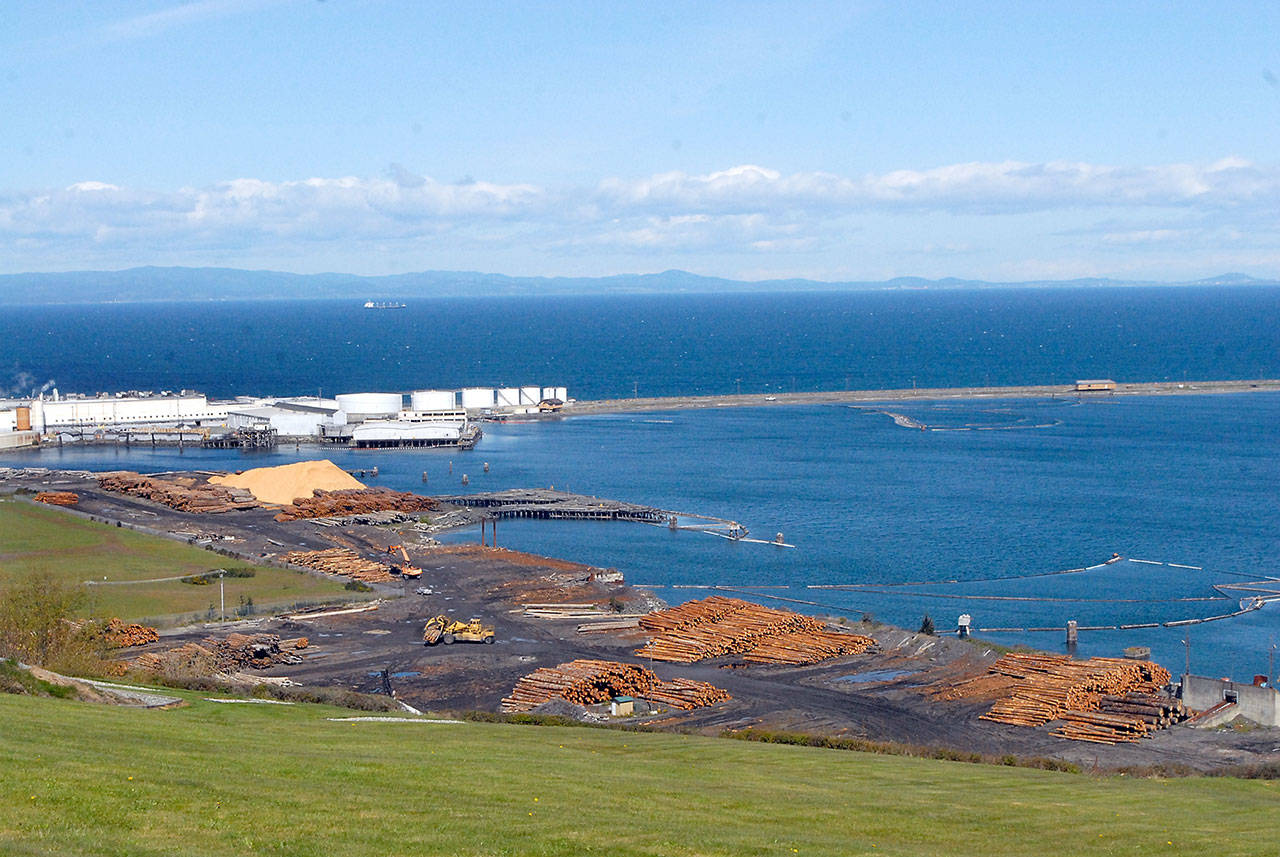PORT ANGELES — Restoration of polluted Port Angeles Harbor will focus on nearshore and shoreline revival along the city’s busy waterfront, where access will be a major challenge, according to federal officials.
But the degree to which layers of log waste and other toxic industrial detritus on the bottom of the largest natural deep-water port on the West Coast will be addressed remains an open question.
“We think the lack of shoreline habitat is more valuable to the overall ecological health of the harbor than working in deep, subtidal habitat,” said Paul Cereghino, restoration ecologist for U.S. National Oceanic and Atmospheric Administration (NOAA), at a public webinar on Wednesday.
Restoration of what state and federal officials refer to as Western Port Angeles Harbor, which covers 2,139 acres of the harbor from the tip of Ediz Hook west to the McKinley Paper Company mill, was the topic of the webinar.
A smaller cleanup and restoration area east of Ediz Hook that includes the former Rayonier Inc. pulp mill property was not the focus of Wednesday’s meeting and is part of a slower, ongoing but similar process involving Rayonier, area tribes and state and federal agencies.
Cleanup of both sites is governed by the state Model Toxics Control Act, which falls under the state Department of Ecology’s purview, while restoration is under the federal Natural Resource Damage Assessment (NRDA) process, and that was the focus of Wednesday’s meeting for the Western Harbor site.
The meeting was hosted by NRDA trustees responsible for conducting the restoration and will choose, under federal law, which projects will be enacted.
They are the Lower Elwha Klallam Tribe, Jamestown S’Klallam Tribe, Port Gamble S’Klallam Tribe, NOAA, U.S. Fish and Wildlife Service and Ecology.
Restoration will be funded under a $9.3 million settlement for natural resource damages that includes $8.5 million for projects to address damage done to the harbor’s natural resources through decades of industrial degradation, according to the Damage Assessment and Restoration Plan (DARP).
Paying into that settlement were the city of Port Angeles, Port of Port Angeles, Georgia-Pacific LLC, Merrill & Ring Inc., Owens Corning and Nippon Paper Industries USA Co., Ltd., owned by McKinley.
“A history of plywood, pulp, and paper manufacturing, marine shipping, boat building and refurbishing, fueling facilities, marinas, commercial fishing, stormwater and sewer discharge, and process wastewater discharge has led to discharges of petrochemicals, organic toxins, heavy metals, and other hazardous substances,” it says.
The plan and consent decrees are available at Ecology’s website, ecology.wa.gov, at the agency’s Port Angeles Harbor NRDA webpage and can be commented upon through April 26. Submit comments on the consent decrees at pubcomment-ees.enrd@usdoj.gov and the DARP at Connie.Groven@ecy.wa.gov.
“Its a milestone of progress for the NRDA with this settlement,” Rebecca Lawson, Ecology’s southwest region manager, said Thursday.
Thirty-six people attended along with 13 panelists, of whom three gave presentations, including Cereghino, who wrote the DARP and outlined restoration options.
NRDA’s goal is to compensate the public for injuries to the harbor’s natural resources in a process led by the trustees under the Model Toxics Control Act and Comprehensive Environmental Response, Compensation, and Liability Act, also known as Superfund, which also authorizes natural resource damage assessment claims.
“CERCLA kind of provides for these claims and these damage assessments,” Lawson said.
Cleanup of the Western Harbor is led by Ecology under a separate process guided by the state Model Toxics Control Act, with the Lower Elwha Klallam Tribe participating,
Carcinogenic polychorlinated biphenyls (PCBs) were concentrated near the city’s shoreline from the McKinley mill east to the midpoint of the port’s Port Angeles Boat Haven, according to Cereghino’s slide presentation.
And harmful policyclic aromatic hydrocarbons (PAHs) were concentrated near the shoreline from east of the mill a short distance up Ediz Hook to around the crook of the harbor at McKinley and east to City Pier.
Cereghino said potential restoration include removal of fish-passage barriers and estuary fill, wood debris remediation, shoreline debris removal, beach construction, sediment-materials placement, native plantings, channel restoration and subtidal planting.
Restoration goals include increasing forage fish and salmonid populations within the harbor, but close to the shoreline.
Restoration is more valuable than focusing on developing more public access or uses, Cereghino said.
The multiple uses and ownerships along the shoreline will present roadblocks to restoration, he said.
“After assessing the harbor, we recognize that land access is going to the primary hurdle,” Cereghino said.
“Our initial work is probably gong to be somewhat quiet and focused on a series of discussions and negotiations with existing private landowners [and] public land managers.”
Restoration actions selected by the trustees will be “highly regulated” under the National Environmental Policy Act, Cereghino said.
________
Senior Staff Writer Paul Gottlieb can be reached at 360-452-2345, ext. 55650, or at pgottlieb@peninsuladailynews.com.

